Edward Burne-Jones
Category: Books,Arts & Photography,Individual Artists
Edward Burne-Jones Details
Sir Edward Coley Burne Jones (1833-1898) was a master of drawing, painted glass and ceramic art. Initially fascinated by Botticelli, Mantegna and Michelangelo, he later turned to Gabriel Rossetti and the early Pre-Raphaelites. Little concerned with the details of daily reality, he probed medieval literature for new themes and produced works that idolize Victorian values and the Englishwoman. These ancient legends gave him a freedom of expression denied elsewhere in a victorian society. Famous if not notorious for always dressing in black. Burne-Jones was the epitome of licentiousness, as a recent London exhibition made delightfully plain to all.

Reviews
Edward Burne-Jones's aesthetic and medieval subjects put him in league with the Pre-Raphaelite brotherhood, but by the 1870s, his mature style crystallized into something quite original. His works had a definite influence on symbolism and even at the dawn of the 20th century, Kandinsky observed that Burne-Jones was an important link in the development of modern art. This book examines Burne-Jones's loose connection with the Pre-Raphaelites, his personal relationships, his portrayal of women, and the power of his art.Like other books by Parkstone Press, the book is small (8.5 x 5 in.) and short (96 p.) with a minimal amount of text that can be read in an hour. It is not going to satisfy those looking for a coffee table book, exhaustive catalogue, or full biography of Burne-Jones. But Patrick Bade supplies a riveting overview of Burne-Jones's life and art in an accessible manner. That doesn't mean the content is thin, but there's very little text per page. At any rate, the text is actually enjoyable to read because Bade writes with a refreshingly direct tone. Bade also provides ample quotations from Burne-Jones himself, along with several scholarly citations.This book has some drawbacks. First, as with most Parkstone Press books, there is a bias towards the artist's sexuality and treatment of the female body in his art. These details seem to be more interesting to this publisher and the author. As such, Bade spends time discussing Burne-Jones's wife, his affair with Mary Zambaco, and his general proclivities for the fairer sex. Second, there are several typos and one instance in which an entire paragraph is accidentally reprinted twice. Third, many of the reproductions in the book are not discussed at all in the text. Conversely, some of the art Bade talks about is not reproduced in the book. Lastly, there is little discussion of Burne-Jones's technique, his glass works, or the formal qualities of his paintings, and some masterpieces are omitted. I don't mind these failings in a bargain book like this, but some readers might.Bottom line: This book is better suited as a Burne-Jones primer for the layman. To the credit of Parkstone Press, even if these bargain books are quick reads, they are beautifully printed with lavish reproductions of an agreeable quality. For superior monographs and picture books on Burne-Jones, consider Edward Burne-Jones: The Earthly Paradise,Edward Burne-Jones: Victorian Artist-Dreamer, and this full biography, Edward Burne Jones.


